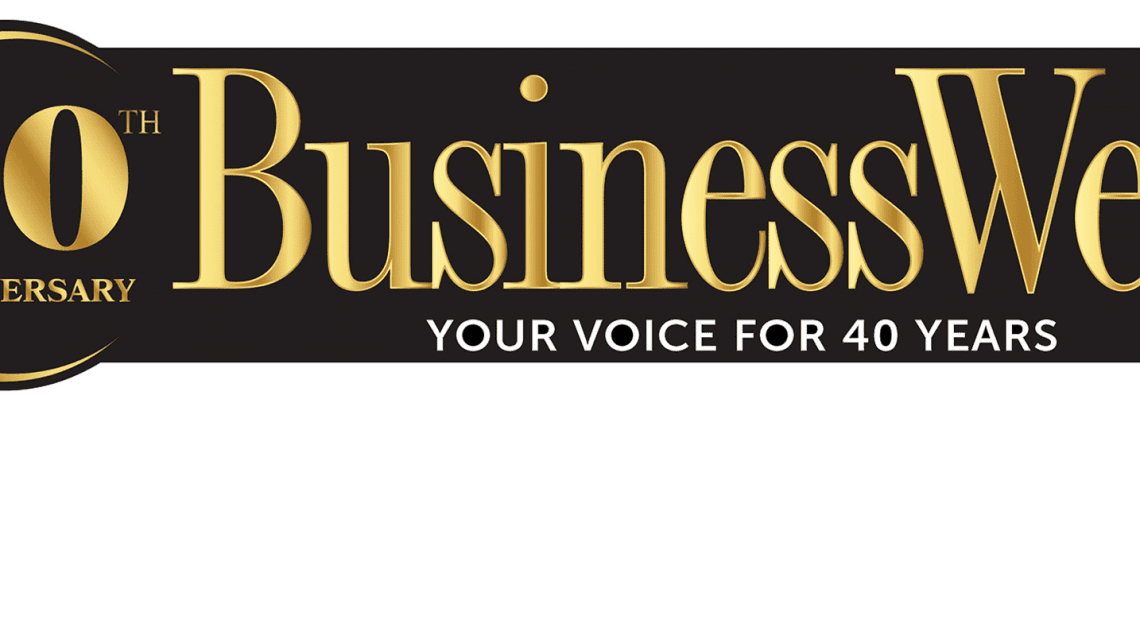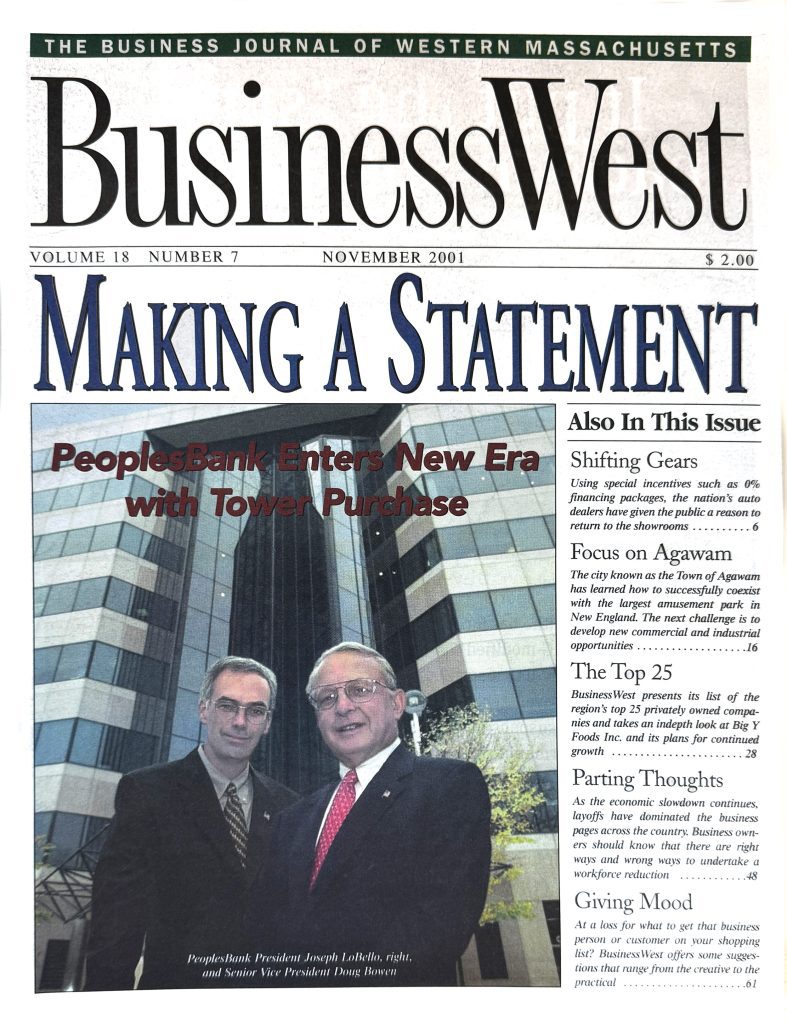
40 Years of Banking
The Environment Has Shifted Profoundly
 Tom Senecal used some hard numbers to detail what is perhaps the biggest change in the banking industry over the past four decades.
Tom Senecal used some hard numbers to detail what is perhaps the biggest change in the banking industry over the past four decades.
“In 1985, there were 18,400 banks in this country,” said Senecal, chairman of Holyoke-based PeoplesBank. “We are now down to 4,600; we’ve lost 13,000 banks in those 40 years. Credit unions … there were around 12,000; now they’re down to 4,200, so they’ve lost more than 7,000. In Massachusetts and Connecticut, there were 230 banks in 1985; I think we’re down to 130, and we expect to be down to 80 by 2030.”
That consolidation, brought on by many factors, but especially the higher cost of doing business and shrinking margins, has changed the local landscape in all kinds of ways, including commercial real estate, with dozens of former bank buildings and offices given over to new uses, from jewelry stores to cannabis dispensaries.
Indeed, it would take quite a bit of space in this story to list all the banks that were here 40, 30, or 20 years ago that aren’t here anymore. Just a partial list would include, on the larger-institution side, Bank of New England, Springfield Institution for Savings, and BayBank (names and letters that were once on office towers in downtown Springfield), and also Shawmut, Fleet, and BankBoston. On the smaller, community-bank side, Hampden, Heritage, Chicopee Savings, United, Woronoco, and Westbank are just some of the names that have disappeared from the landscape.
All of this is reflected in the large collections of business cards amassed by some bankers in this area, sometimes without actually leaving their office — it was only the name and logo on the card that changed.
But consolidation of the industry (and we’ll get back to it later) is obviously just one of many changes in this sector since Ronald Reagan was running for a second term in the White House. There have been huge changes in technology and how people bank, in how many non-bank entities are now vying for market share in this industry, and also in how people work, where, and even what they wear to the office.
Indeed, Lauren Duffy, executive vice president and COO of UMassFive College Federal Credit Union, is one of many officers at the institution that do not have their own office anymore. She works remotely a few days a week, and for the days she’s in, she reserves a desk online.
“I try to make sure I get one with a good window,” she told BusinessWest, adding that she usually does. And this sea change is only one of many in the world of credit unions, which four decades ago might have served the employees of one company or institution (like UMass Amherst or Mercy Hospital) and now have memberships that are much larger and more diverse.
There have been other changes as well, said Glenn Welch, president and CEO of Freedom Credit Union, who has almost exactly 40 years of experience in the industry and is one of those who saw his business card change repeatedly, but not the location of his desk. He said the business is, well, less formal now, reflecting trends across business.
“When I started out back in the ’80s, you had to wear a suit and tie every day,” he recalled. “If you left the floor you were working on, you had to put your suit jacket back on; you couldn’t walk through the lobby without being very formal.”
Dan Moriarty
“Over my career, people have always been talking about how branches were dying or how we wouldn’t need anymore. But for small community banks or community banks in general, a physical presence will always be a necessity.”
Getting back to technology, it is a thread that runs through each and every story in our 40th-anniversary edition, and for good reason. In banking, the changes have been profound, with paper and old-fashioned bankbooks giving way to automated tellers and mobile banking, greatly reducing the need to visit the local branch and generating discussion and debate about whether banks will need such facilities moving forward — and, if so, how many.
Senecal said PeoplesBank plans to add three branches just this year as the institution plots an organic growth strategy while also looking hard at mergers and acquisitions. Meanwhile, Dave Glidden, president and CEO of Middletown, Conn.-based Liberty Bank, can see a day, not far ahead, when the bank will make net reductions in the number of branches in its portfolio. And Dan Moriarty, president and CEO of Monson Savings Bank, like others we spoke with, noted that, while the branch is visited less often today than before, and this trend will likely accelerate in the future, there will always be a need for face-to-face, in-person service.
“Over my career, people have always been talking about how branches were dying or how we wouldn’t need anymore,” Moriarty said. “But for small community banks or community banks in general, a physical presence will always be a necessity.”
By All Accounts
As he talked about the changes that have come to this sector since he entered the business more than 30 years ago, Senecal reflected on the building, and the office, he was sitting in.
This is the inverted-triangle-shaped office tower off I-91, across the street from the Holyoke Mall. It was once the headquarters to Heritage Bank, which famously failed amid excess and scandal in 1992, a time when many institutions were failing and the banking industry was in a state of turmoil.
Lauren Duffy
“When I started working in credit unions almost 20 years ago, our financial services were fairly simple. It was a savings account, a checking account, and, most commonly, a car loan, a mortgage, or a personal loan. We’ve evolved with the economy and with the region, and it’s so complex now, the many things that we can offer.”
“The top floor here, the eighth floor, is much larger than the second floor, because of the shape of the building,” he explained. “Heritage had four offices on the eighth floor; we have maybe 30 on the second floor now. The eighth floor was extremely opulent. Joe Lobello, our president at the time, was pretty adamant that he did want the negative association of a failed bank; we were looking to move our headquarters, but he did not want to buy this building because of that negative association.
“Joe realized how inexpensive it would be to buy this building as opposed to building something new, so he finally acquiesced,” Senecal went on. “But my office is on the second floor because Joe did not want to be associated with the opulence of the eighth floor. Twenty-five or so years ago, Joe’s office was on the second floor, and today, my office is still here.”
Perhaps, but very little else about this sector is the same as it was a few decades ago. As noted earlier, institutions have disappeared, and many others have changed their name, in many cases dropping the word ‘Savings’ from the sign over the door because that word did not accurately reflect all that an institution could provide for its clients.
“When I started working in credit unions almost 20 years ago, our financial services were fairly simple,” said Duffy, speaking for other credit unions and banks as well. “It was a savings account, a checking account, and, most commonly, a car loan, a mortgage, or a personal loan. We’ve evolved with the economy and with the region, and it’s so complex now, the many things that we can offer — all the many things that we can do with cards and mobile apps, and all the ways we’re trying to be more accessible to people and really innovating around the idea of financial wellness.
Glenn Welch
“There’s not necessarily that loyalty now, especially when people can go online and see what others are paying on accounts or charging for fees or charging for loan rates. So you have to be more competitive.”
“That’s what credit unions were founded to address all those years ago,” she went on. “But we were addressing it in a more simple way 40 years ago than we are today.”
Meanwhile, the Massachusetts/Connecticut border, which wasn’t crossed by institutions based on either side years ago, is now readily crossed, with PeoplesBank advancing south, for example, and Liberty marching north.
The biggest change, though, has come in how people bank and the technology they use. It brings convenience, obviously, with people able to do almost everything by phone now.
This convenience brings expectations, on the part of consumers and commercial clients alike, Glidden said. “Everyone is trying to deliver that Amazon experience, and it’s of great importance today for a bank to stay up with what the consumer’s expectations are — and that’s higher, probably, than what banks have historically delivered.”
But this convenience also brings the ability to change banks quite easily, said Welch, which is forcing institutions of all sizes to pay even more attention to what the competition is doing and adjust to remain competitive.
“At the touch of a button, people can move their money anywhere, within seconds or minutes,” he said. “It used to be that you would have to go into the bank and have them draw up a cashier’s check, go down the street, sit down with someone to open a deposit account, and then move money over. Now, it can be done in an instant.
Dave Glidden
“Everyone is trying to deliver that Amazon experience, and it’s of great importance today for a bank to stay up with what the consumer’s expectations are — and that’s higher, probably, than what banks have historically delivered.”
“So there’s not necessarily that loyalty now, especially when people can go online and see what others are paying on accounts or charging for fees or charging for loan rates,” Welch went on. “So you have to be more competitive.”
Senecal agreed, noting that this is just one of the many pressures facing financial institutions today.
“Banks used to have 4% margins; getting out of bed, they had 4% margins — they didn’t have to do anything,” he explained. “Margins are down to 2.5% now and struggling to get to 3%. No banks in this country are enjoying those 4% margins we used to enjoy because information is so readily available that consumer behavior can change in an instant. You can move your money so fast, and that sort of competition drives attractive prices — it drives mortgage rates down, and it drives savings rates up, which squeezes margins.”
Points of Interest
This simple math explains why size is more important than ever before in this industry, and thus why the current pattern of mergers and acquisitions will continue into the future, with both banks and credit unions.
“It’s a consolidating industry, and we’ll continue to consolidate,” said Glidden, adding that, for a number of reasons, ranging from rising interest rates to the current administration in the White House, the pace of such transactions has slowed somewhat in recent years.
But consolidation will continue, he said, and especially on the community-bank level.
And while the number of banks continues to shrink, it is likely that there will be fewer of the traditional branches that have come to symbolize the industry, said Glidden, who worked for many of those institutions no longer here — Shawmut and then Bank of Western Massachusetts., for example — before arriving at SIS (which was later acquired by Banknorth, which was subsequently acquired by TD Bank), before moving on to Liberty.
He made it clear that branches are still critical to any institution’s success, and they provide great visibility. But there is no denying that use of these facilities continues to decline.
“Many of our younger generations have never been in a branch and probably never will be in a branch and are fine with a totally digital banking experience,” he said. “And this has really changed the dynamic of how we as bankers and financial advisers have to respond and engage our customers.
“Years ago, you might have gone to the branch once a week, or, if you were a small-business owner, you might go five times a week,” Glidden went on. “The reality now is that you might go the branch every two or three weeks, or you might go to it when you really have a question or problem you want resolved and you don’t want to do it through the call center or any of the other channels.”
As a result of these trends, banks are looking to maximize the visits that do happen, he said, while also thinking hard about consolidating their branches. He can see a day a bank with maybe 20 branches in an area like Greater Springfield might want to get down to 10.
Moriarty agreed that fewer people are visiting branches and those that do visit them less often, but he stressed that there will always be a need for such facilities.
“I feel that customers still want to come in and talk to someone, either to better understand a product or get advice or just get that face-to-face interaction because trust is a big part of the equation,” he told BusinessWest. “Down the road, we’ll still see that kind of interaction because people want and need it.”
Whether they will still need cash is another story, he went on, adding that, given the pace of change and the emergence of debit cards, he wonders how long consumers will still need coins and currency.
That might be the next chapter in the ongoing evolution of banks, credit unions, and the entire financial-services industry.








